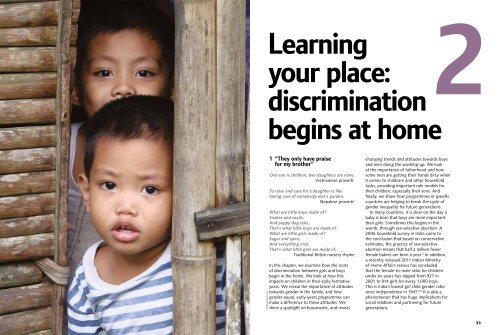Create successful ePaper yourself
Turn your PDF publications into a flip-book with our unique Google optimized e-Paper software.
Learning<br />
your place:<br />
discrimination<br />
begins at home<br />
2<br />
B o n n i e M i l l e r<br />
1 “They only have praise<br />
for my brother”<br />
One son is children, two daughters are none.<br />
Vietn<strong>am</strong>ese proverb 1<br />
To raise and care for a daughter is like<br />
taking care of somebody else’s garden.<br />
Nepalese proverb 2<br />
What are little boys made of?<br />
Snakes and snails,<br />
And puppy dog tails,<br />
That’s what little boys are made of.<br />
What are little girls made of?<br />
Sugar and spice,<br />
And everything nice,<br />
That’s what little girls are made of.<br />
Traditional British nursery rhyme<br />
In this chapter, we ex<strong>am</strong>ine how the roots<br />
of discrimination between girls and boys<br />
begin in the home. We look at how this<br />
impacts on children in their early formative<br />
years. We reveal the importance of attitudes<br />
towards gender in the f<strong>am</strong>ily, and how<br />
gender-equal, early-years progr<strong>am</strong>mes can<br />
make a difference to these attitudes. We<br />
shine a spotlight on housework, and reveal<br />
changing trends and attitudes towards boys<br />
and men doing the washing-up. We look<br />
at the importance of fatherhood and how<br />
some men are getting their hands dirty when<br />
it comes to childcare and other household<br />
tasks, providing important role models for<br />
their children, especially their sons. And<br />
finally, we show how progr<strong>am</strong>mes in specific<br />
countries are helping to break the cycle of<br />
gender inequality for future generations.<br />
In many countries, it is clear on the day a<br />
baby is born that boys are more important<br />
than girls. Sometimes this begins in the<br />
womb, through sex-selective abortion. A<br />
2006 household survey in India c<strong>am</strong>e to<br />
the conclusion that based on conservative<br />
estimates, the practice of sex-selective<br />
abortion means that half a million fewer<br />
female babies are born a year. 3 In addition,<br />
a recently released 2011 Indian Ministry<br />
of Home Affairs census has concluded<br />
that the female-to-male ratio for children<br />
under six years has slipped from 927 in<br />
2001 to 914 girls for every 1,000 boys.<br />
This is India’s lowest girl child gender ratio<br />
since independence in 1947. 4,5 It is also a<br />
phenomenon that has huge implications for<br />
social relations and partnering for future<br />
generations.<br />
32 the s tate of the world’s girls 33

















